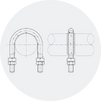
The Piping Stress and Flexibility Analysis course equips learners with the skills to evaluate piping systems under various operating and environmental conditions. It focuses on stress analysis fundamentals, flexibility design, support optimization, and compliance with international codes. Participants gain hands-on experience with industry-standard tools like CAESAR II, enabling them to design safe, reliable, and cost-effective piping systems for oil & gas, power, chemical, and other process industries.
Piping Stress and Flexibility Analysis Training Interview Questions Answers - For Intermediate
1. What is the difference between sustained and expansion stresses in piping?
Sustained stresses are caused by constant loads such as internal pressure and the weight of the pipe and its contents, remaining present during normal operation. Expansion stresses arise due to displacement loads, primarily thermal expansion or contraction, and are cyclic in nature, leading to potential fatigue issues if not properly addressed.
2. How do you handle displacement loads in piping stress analysis?
Displacement loads result from thermal expansion, differential settlement, or equipment movement. These are modeled as imposed displacements in the analysis software, and the piping layout is designed with loops, offsets, or expansion joints to accommodate these movements while staying within stress limits.
3. Why are piping codes like ASME B31.1 and B31.3 important in stress analysis?
Piping codes such as ASME B31.1 for power piping and ASME B31.3 for process piping provide standardized design rules, material limits, stress formulas, and safety factors. Compliance ensures the piping system meets safety, reliability, and operational requirements in line with industry best practices.
4. What is the purpose of spring hangers in piping systems?
Spring hangers are used where vertical movements occur due to thermal expansion or equipment settlement. They provide variable or constant support loads to prevent excessive stress or reactions on connected equipment while maintaining proper system flexibility.
5. How do you evaluate nozzle loads on rotating equipment?
Nozzle loads on pumps, compressors, or turbines are evaluated against vendor-specified allowable limits, often following standards like API 610 or NEMA SM23. If calculated loads exceed limits, piping routing or flexibility must be modified to protect equipment integrity and alignment.
6. What are guide and anchor supports in piping systems?
Guide supports restrict lateral movement while allowing axial thermal expansion, preventing excessive bending stresses. Anchor supports, on the other hand, completely restrain pipe movement in all directions, creating a fixed point to control expansion in defined segments of the piping system.
7. How is wind load considered in piping stress analysis?
Wind loads are applied as lateral forces on exposed piping systems, typically following design codes such as ASCE 7. The resulting stresses and support reactions are checked under occasional load cases to ensure system stability and structural integrity during high wind conditions.
8. What are the main types of piping loads in stress analysis?
The primary types include sustained loads (weight, pressure), expansion loads (thermal movements), and occasional loads (seismic, wind, water hammer). Each load category is analyzed separately or in combination, as per code requirements, to verify overall system safety.
9. How is seismic load analysis performed for piping systems?
Seismic loads are calculated based on seismic zoning, building codes like ASCE or IS 1893, and structural response factors. These loads are applied as acceleration forces to the piping system, ensuring it can withstand earthquake-induced stresses without failure.
10. Why is cold springing used in piping design?
Cold springing involves pre-stressing the piping during installation by intentionally offsetting the pipe before final welding. This method helps reduce thermal expansion stresses during operation, improving flexibility without major layout modifications.
11. How does pipe diameter affect flexibility and stress levels?
Larger diameter pipes tend to have higher stiffness, reducing flexibility and increasing thermal expansion stresses. Smaller diameter pipes, being more flexible, can absorb thermal movements better but may need additional supports to prevent sagging or vibration issues.
12. What is the significance of fatigue curves in stress analysis?
Fatigue curves show the relationship between stress amplitude and the number of allowable load cycles before failure. These curves are used to assess cyclic loading conditions in piping systems, ensuring long-term durability under repeated thermal or pressure variations.
13. How is piping vibration analyzed in stress studies?
Vibration analysis involves checking natural frequencies, excitation sources like pumps or compressors, and resonance conditions. Supports, dampers, or design modifications are introduced to prevent vibration-induced fatigue or noise problems in the piping system.
14. Why is it important to consider settlement loads in piping analysis?
Settlement loads occur when equipment foundations or supports shift over time. If ignored, differential settlement can induce unexpected stresses, misalignment, and equipment damage, so flexible connections or sliding supports are used to mitigate these effects.
15. How do you ensure system flexibility in a congested plant layout?
In restricted spaces, system flexibility is ensured by routing with expansion loops, offsets, or using expansion joints strategically. Additionally, pipe stress software is used to iterate designs and confirm that thermal movements are safely accommodated within available space constraints.
Piping Stress and Flexibility Analysis Training Interview Questions Answers - For Advanced
1. How is time-history analysis applied in piping stress evaluation for dynamic loads?
Time-history analysis evaluates piping system response under time-varying loads like seismic events, water hammer, or blast impacts. Unlike static or response spectrum methods, time-history analysis captures the actual load sequence, phase differences, and transient effects, providing a detailed displacement, velocity, and acceleration profile. This method uses real or synthetic ground motion data, applying it to the piping model through integration steps over time. It enables engineers to identify peak responses, potential resonance conditions, and nonlinear effects like support gaps or snubber activation. Time-history analysis is computationally intensive but essential for critical systems in nuclear, petrochemical, or offshore facilities where dynamic load characterization directly affects safety and reliability.
2. What is the role of strain-based design in piping systems under extreme conditions?
Traditional piping design focuses on stress limits; however, under extreme events like earthquakes or high-pressure transients, strain-based design ensures the piping system maintains integrity beyond elastic limits. This approach evaluates the total strain capacity, accounting for plastic deformation without catastrophic failure. It is especially relevant for high-temperature, high-pressure pipelines or systems subject to ground movement, where controlled yielding is acceptable to prevent rupture. Standards like ASME B31.4 and B31.8 incorporate strain-based methods for pipeline systems, ensuring resilience against deformation-induced failures while optimizing material utilization and safety margins.
3. How are offshore piping systems analyzed for wave and current loads?
Offshore piping systems experience combined effects of wave, current, wind, and platform motion. Hydrodynamic analyses using Morison’s equation or spectral wave models calculate drag, inertia, and lift forces acting on exposed piping. The results feed into structural-piping interaction models, accounting for dynamic amplification, fatigue from wave cyclic loading, and potential vortex-induced vibrations (VIV). For floating platforms, relative motion between piping and structure requires flexible connections, articulated joints, or expansion loops to prevent overstressing. Offshore design codes like DNV-ST-F101 and API RP 2A guide load combinations, safety factors, and fatigue life assessments for marine environments.
4. How is fracture mechanics applied in piping stress and flexibility analysis?
Fracture mechanics evaluates the behavior of existing flaws or cracks under operational loads, predicting potential failure mechanisms. Parameters like stress intensity factor (K), fracture toughness (K_IC), and crack growth rates (da/dN) help estimate remaining life and safe operating conditions. Integration with piping stress results identifies critical locations where high cyclic stresses may accelerate crack growth. Standards like API 579-1/ASME FFS-1 provide guidelines for Level 2 and Level 3 fracture mechanics assessments, enabling decisions on repair, replacement, or continued operation under monitored conditions. This approach is vital for aging assets, high-pressure systems, or safety-critical pipelines.
5. How are non-metallic piping materials analyzed for stress and flexibility?
Non-metallic materials like FRP (Fiber Reinforced Plastic), GRE (Glass Reinforced Epoxy), or HDPE require specialized analysis because they exhibit anisotropy, lower modulus of elasticity, and different stress limits compared to steel. Codes such as ASME B31.3 Chapter VII or ISO 14692 define material-specific stress criteria, allowable strain limits, and joining methods. Flexibility analysis must account for higher thermal expansion coefficients, lower stiffness, and sensitivity to creep or UV degradation. Software tools incorporate these properties to ensure realistic modeling of stress intensities, support spacing, and allowable loads on fittings or joints for long-term reliability.
6. How are snubbers used in piping systems, and how is their dynamic behavior modeled?
Snubbers protect piping systems against sudden dynamic loads like earthquakes or steam hammer events by allowing free thermal movement during normal operation but locking under rapid accelerations. Two main types are hydraulic and mechanical snubbers. Their dynamic stiffness, damping characteristics, and activation thresholds must be accurately modeled in stress analysis software to simulate realistic load transfer. Regular testing and maintenance ensure reliable performance since snubbers may degrade over time. Proper placement near critical equipment nozzles or long piping runs helps minimize dynamic overstressing without restricting thermal flexibility.
7. How do you analyze piping systems with dual-phase fluids for thermal and pressure effects?
Dual-phase flow involving liquid and vapor phases introduces complexities like flow-induced vibration, slugging, and thermal stratification. Stress analysis must incorporate transient pressure loads from slug flow impacts, uneven temperature distribution from stratification, and potential acoustic resonance from rapid phase changes. Process simulation tools provide input data like pressure surges, void fractions, and flow regimes, which integrate with stress models to assess dynamic forces. Mitigation measures include installing separators, surge suppression devices, and adequate flexibility loops to handle pressure and temperature variations safely.
8. What is the significance of the Caesar II load case combination matrix in advanced analysis?
The Caesar II load case combination matrix defines how different load types—sustained, thermal, seismic, wind, and occasional—interact to produce worst-case stress scenarios. For example, sustained plus thermal expansion stresses assess displacement stress ranges, while sustained plus wind or seismic loads check occasional conditions. Advanced users customize the matrix to meet project-specific code requirements, ensuring correct evaluation of primary, secondary, and occasional stresses. Proper load case definition prevents under-design due to missing combinations or over-design from unrealistic load summations, optimizing safety and cost-effectiveness.
9. How are piping systems analyzed for blast overpressure effects in refineries or petrochemical plants?
Blast overpressure from accidental explosions imposes short-duration, high-intensity loads on piping systems. Dynamic analysis using nonlinear time-history methods evaluates structural response under pressure wave profiles defined by API RP 752 or UFC guidelines. Supports and snubbers are designed to withstand impulsive forces while allowing post-blast functionality for critical systems. Blast-resistant layouts, strategic placement of isolation valves, and rupture discs minimize escalation risks. The analysis ensures life safety, asset protection, and compliance with process safety management requirements in high-risk facilities.
10. How are thermal ratcheting and shakedown phenomena evaluated in piping systems?
Thermal ratcheting occurs when cyclic thermal loads cause progressive plastic deformation due to stress redistribution, while shakedown refers to stabilization after initial yielding. ASME Section VIII Div. 2 and RCC-MR codes provide criteria for evaluating these effects using elastic-plastic analysis or Bree diagrams. Piping stress results combined with temperature profiles help predict whether the system will stabilize (shakedown) or fail progressively (ratcheting). Design measures like increasing wall thickness, reducing thermal gradients, or adding flexibility loops prevent long-term distortion or fatigue damage from these phenomena.
11. How do you evaluate piping systems for soil-structure interaction in seismic conditions?
For buried or partially buried piping, soil-structure interaction (SSI) significantly influences seismic response. Analysis uses wave propagation theory, site-specific soil properties, and finite element soil-spring models to simulate realistic restraint effects. Standards like ASCE 4 or ALA guidelines define seismic wave inputs, damping ratios, and stiffness coefficients for SSI modeling. Flexible joints, thrust blocks, or above-ground expansion loops may be introduced near transitions to prevent overstressing at interfaces between buried and above-ground sections.
12. How are high-cycle vibration problems diagnosed and mitigated in operating plants?
High-cycle vibration often results from flow turbulence, mechanical excitation, or acoustic resonance, leading to fatigue failures at welds, small-bore branches, or instrument connections. Field measurements using strain gauges, accelerometers, and high-speed cameras identify vibration frequencies, amplitudes, and potential resonance locations. Mitigation measures include adding stiffeners, dynamic dampers, or tuned mass absorbers, redesigning flow paths, or adjusting support spacing. Standards like Energy Institute Guidelines for FIV/AIV provide systematic screening, assessment, and control methodologies for operational reliability.
13. How are creep and relaxation effects considered in long-term high-temperature piping systems?
At elevated temperatures, materials experience time-dependent deformation (creep) and stress relaxation, reducing load-carrying capacity over years of operation. ASME B31.3 and API 530 provide allowable stress limits incorporating creep rupture data for long-term service. Stress analysis must include secondary loads, sustained stresses, and thermal cycles to estimate creep-fatigue interaction effects. Design solutions involve selecting creep-resistant alloys, reducing operating temperatures, or adding flexibility to minimize sustained load levels and extend service life.
14. How is piping stress analysis integrated with pipe support design optimization?
Piping stress and support design are interdependent—support locations affect system flexibility, while flexibility affects support loads. Iterative analysis ensures optimal placement of anchors, guides, springs, and snubbers to balance thermal movement accommodation with structural load limits. Modern tools integrate piping and structural analysis, enabling automated optimization based on displacement limits, nozzle loads, and cost constraints. This holistic approach minimizes over-conservative designs while ensuring safety and compliance with structural codes like AISC or Eurocode.
15. How do digital twins and real-time monitoring enhance piping stress management?
Digital twins combine 3D piping models, real-time sensor data, and predictive analytics to continuously monitor stress, temperature, and vibration conditions during operation. Coupled with IIoT sensors and AI algorithms, they detect anomalies like excessive displacement, support settlement, or thermal excursions before failures occur. Integration with advanced stress analysis models enables predictive maintenance, remaining life assessment, and what-if scenario evaluation, transforming piping systems from static designs to actively managed assets throughout their lifecycle.
Course Schedule
| Dec, 2025 | Weekdays | Mon-Fri | Enquire Now |
| Weekend | Sat-Sun | Enquire Now | |
| Jan, 2026 | Weekdays | Mon-Fri | Enquire Now |
| Weekend | Sat-Sun | Enquire Now |
Related Courses
Related Articles
Related Interview
- SAP IBP Response Planning Training Interview Questions Answers
- HR110 - Business Processes in SAP HCM payroll Training Interview Questions Answers
- Kronos Workforce (UKG) Dimensions - Interview Question Answers
- Oracle PeopleSoft Admin Interview Questions Answers
- Bentley Open Rail Interview Questions Answers
Related FAQ's
- Instructor-led Live Online Interactive Training
- Project Based Customized Learning
- Fast Track Training Program
- Self-paced learning
- In one-on-one training, you have the flexibility to choose the days, timings, and duration according to your preferences.
- We create a personalized training calendar based on your chosen schedule.
- Complete Live Online Interactive Training of the Course
- After Training Recorded Videos
- Session-wise Learning Material and notes for lifetime
- Practical & Assignments exercises
- Global Course Completion Certificate
- 24x7 after Training Support






 Join our Live Instructor-Led online classes delivered by industry experts
Join our Live Instructor-Led online classes delivered by industry experts